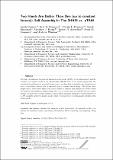Two Hands Are Better Than One (up to constant factors): Self-Assembly In The 2HAM vs. aTAM
Author(s)
Demaine, Erik D.; Demaine, Martin L.; Eisenstat, Sarah Charmian; Cannon, Sarah; Patitz, Matthew J.; Schweller, Robert T.; Summers, Scott M.; Winslow, Andrew; ... Show more Show less
DownloadDemaine_Two hands.pdf (850.1Kb)
PUBLISHER_CC
Publisher with Creative Commons License
Creative Commons Attribution
Terms of use
Metadata
Show full item recordAbstract
We study the difference between the standard seeded model (aTAM) of tile self-assembly, and the "seedless" two-handed model of tile self-assembly (2HAM). Most of our results suggest that the two-handed model is more powerful. In particular, we show how to simulate any seeded system with a two-handed system that is essentially just a constant factor larger. We exhibit finite shapes with a busy-beaver separation in the number of distinct tiles required by seeded versus two-handed, and exhibit an infinite shape that can be constructed two-handed but not seeded. Finally, we show that verifying whether a given system uniquely assembles a desired supertile is co-NP-complete in the two-handed model, while it was known to be polynomially solvable in the seeded model.
Date issued
2013Department
Massachusetts Institute of Technology. Computer Science and Artificial Intelligence Laboratory; Massachusetts Institute of Technology. Department of Electrical Engineering and Computer ScienceJournal
Proceedings of the International Symposium on Theoretical Aspects of Computer Science, STACS 2013
Publisher
Schloss Dagstuhl Publishing
Citation
Cannon, Sarah, Erik D. Demaine, Martin L. Demaine, Sarah Eisenstat, Matthew J. Patitz, Scott M. Summers, and Andrew Winslow. "Two Hands Are Better Than One (up to constant factors): Self-Assembly In The 2HAM vs. aTAM." 30th International Symposium on Theoretical Aspects of Computer Science (STACS 2013), Feb.27-Mar. 2nd, 2013, Kiel, Germany.
Version: Final published version
ISBN
9783939897507
3939897507